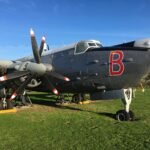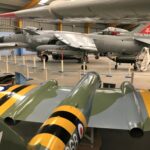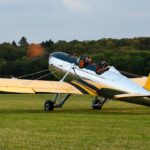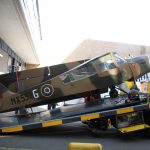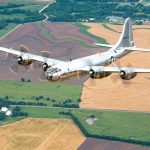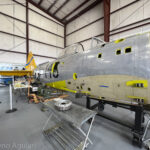By Zac Yates
On July 10th, 1999 an anonymous Auster AOP.9 arrived at the Newark Air Museum (NAM) in Nottinghamshire, UK. Nearly 25 years later, on January 25th, 2024, a major milestone was passed in its long-term restoration when an engine was refitted to the airframe for the first time.
The last of a line of successful military and civilian light aircraft with their genesis in the original Taylor Cub of the 1930s, the Auster AOP.9 saw active service with the Royal Air Force and later the Army Air Corps as an air observation post (AOP) in Aden and Malaya. The armed forces of India and South Africa also operated the AOP.9, as did the Royal Hong Kong Auxiliary Air Force. The NAM’s example was placed into deep storage on arrival and brought out for restoration in 2012, however initial efforts were cut short as key members of the team were required to assist on other projects.
“Examination of the manufacturer’s plate on the aircraft gives a slightly confused picture about the military serials that it may have worn. With that in mind the museum sought assistance to clarify the airframe’s identity. XK381 or XS238 are believed to be the most likely; while TA200 and XR238 have also been in the frame. Subsequent dialogue via Wrecks & Relics editor Ken Ellis confirmed the XS238 identity by the release of edition 26 in 2018. For the purpose of this restoration project it will wear the XS238 markings, which is believed to be the most likely identity of the fuselage structure,” Heeley said.
Work is also being undertaken on covering the fuselage and refitting the cockpit area, after which the team’s focus will shift to re-covering the aircraft’s wings with new fabric.
The restoration team is seeking photographs of XS238 in service. If you can assist please contact the museum via their website at http://www.newarkairmuseum.org/







![Newark Air Museum Auster Restoration Update 9 The Newark Air Museum's Auster AOP.9 project now has its Blackburn Cirrus engine in place. [Photo by Howard Heeley - Down To Earth Promotions]](https://vintageaviationnews.com/wp-content/uploads/Auster-AOP.9-Newar-Air-Museum-20240125-Howard-Heeley-DTEP-scaled.jpg)

![Newark Air Museum Auster Restoration Update 10 In 2012 the fuselage of the Auster was brought out of storage and the volunteer team began restoration work. [Photo by Howard Heeley - Down To Earth Promotions]](https://vintageaviationnews.com/wp-content/uploads/Auster-AOP.9-Newark-Air-Museum-20120202-Howard-Heeley-DTEP-898x1024.jpg)
![Newark Air Museum Auster Restoration Update 11 By March 2013 the fuselage frame was on its landing gear and the engine cowlings were test-fitted. [Photo by Howard Heeley - Down To Earth Promotions]](https://vintageaviationnews.com/wp-content/uploads/Auster-AOP.9-Newark-Air-Museum-20130328-Howard-Heeley-DTEP-1024x768.jpg)
![Harvard Restoration at Newark Air Museum Forging Ahead 10 Recent work on the Harvard has focused on refitting the restored engine cowlings after museum volunteers backdated work done by a previous owner. [Photo by Howard Heeley, Down To Earth Promotions]](https://vintageaviationnews.com/wp-content/uploads/42-12417-Newark-Air-Museum-20240701-HH-DTEP-01-150x150.jpg)
